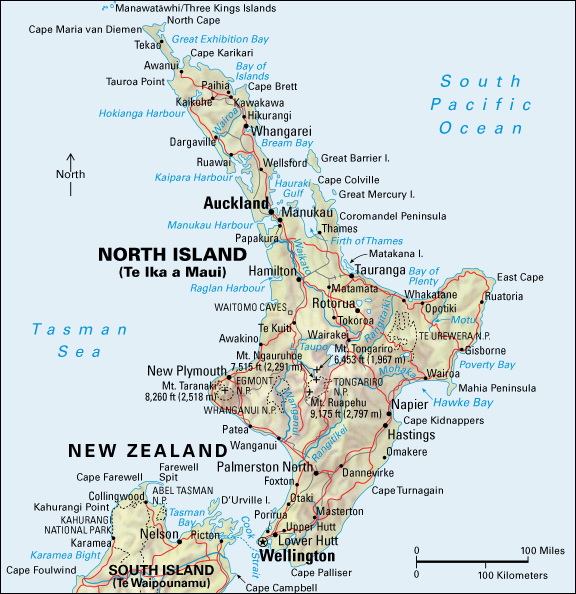North Island (pop. 3,594,552) is the smaller but more populated of New Zealand’s two main islands. The South Island is the other. The North Island has densely populated cities as well as farms, large forests, and mountains and volcanoes.

The North Island is home to New Zealand’s capital, Wellington, and its largest city, Auckland. The traditional Māori name for the North Island, Te Ika-a-Māui << teh ee kah ah mow ee >> , means the fish of Maui. This name refers to an ancient Māori legend in which the demigod Maui pulled the island from the sea using a magic fishhook.
Most of New Zealand’s economic activity takes place on the North Island. Although farming is no longer the staple of New Zealand’s economy, it is still significant. Most of the country’s cattle farms are on the North Island. Today, the island’s economy is based heavily on service industries, which include retail trade, restaurants and hotels, finance, transportation, and community and social services.
The land.
Cook Strait, which is about 16 miles (26 kilometers) wide at its narrowest point, separates the North and South islands. The North Island has an area of 44,701 square miles (115,777 square kilometers).
The northernmost region of the North Island has forests, hills, and lowland farm areas. The eastern and southern parts of the island are mostly hilly and have a system of mountains.
Much of the western and central areas of the island are made up of volcanoes and hills. New Zealand lies along the Ring of Fire, a zone along the edge of the Pacific Ocean that has many volcanoes and earthquakes (see Ring of Fire ). New Zealand has many active and potentially active volcanoes, most of which are on the North Island. These volcanoes include the North Island’s highest point, Mount Ruapehu, which rises 9,175 feet (2,797 meters) over the central part of the island.

History.
The original settlers of New Zealand were a Polynesian people known as Māori (pronounced MOW ree or MAH ree). They sailed to New Zealand from other islands in the Pacific Ocean around A.D. 1200. The British explorer James Cook in 1769 became the first European to set foot on New Zealand. Cook landed at Poverty Bay, on the North Island’s east coast. Although Cook claimed New Zealand for Britain (now part of the United Kingdom), no legal government had authority over the many settlers and traders who came to New Zealand until 1840. That year, the British government declared New Zealand a colony and negotiated the Treaty of Waitangi with Māori chiefs. The treaty, signed at Waitangi on the North Island, made Māori subject to British laws but let them keep ownership of their lands. However, differences in the English and Māori versions of the treaty caused many problems and led to continued conflict between Europeans and Māori. See Waitangi, Treaty of .
Russell, in the Bay of Islands on the North Island, is New Zealand’s oldest European settlement. It was chosen as the new colony’s capital in 1840. The following year, the governor relocated to Auckland, which became the capital. In 1865, the capital was moved to the more central city of Wellington.
